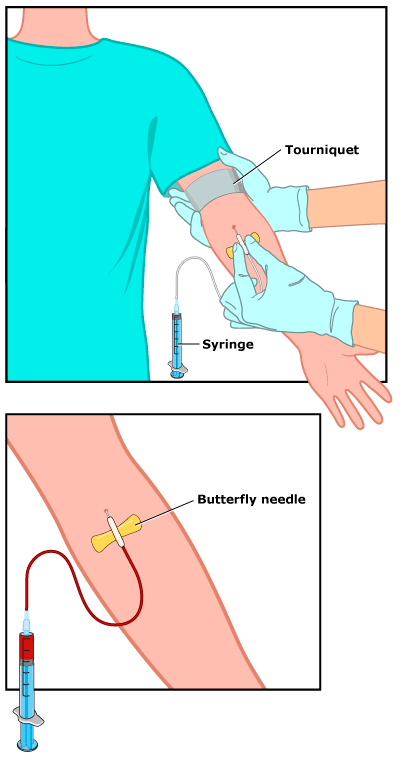Blood Test: 17-Hydroxyprogesterone
Article Translations: (Spanish)
What It Is
The hormone 17-hydroxyprogesterone is a building block for producing the hormone cortisol. Cortisol is produced mainly by the adrenal cortex (the outer part of the two adrenal glands, located above the kidneys). Cortisol is called the "stress hormone" because it's secreted in larger amounts as part of the body's response to physical or emotional stress.
Cortisol levels normally vary throughout the day. They're highest in the morning, just before waking up, and lowest at night.
Some people, however, can't make enough cortisol because they lack an enzyme in the adrenal glands that's needed to make it. They'll have a buildup of 17-hydroxyprogesterone in the blood because it's not being converted to cortisol.
In kids, the most common cause of cortisol deficiency, and consequently high levels of 17-hydroxyprogesterone, is one of the forms of the genetic disorder congenital adrenal hyperplasia (CAH).
CAH can affect both boys and girls. It causes the adrenal glands to make excess androgens (male steroid hormones) and, in some cases, not enough of the hormones that regulate the body's salt balance.
Though treatable, undetected CAH can sometimes lead to more serious symptoms such as dehydration and shock in infants.
Why It's Done
The 17-hydroxyprogesterone test is mainly used to check for the most common form of CAH in infants and children. In some states, it's done as part of a group of routine screening tests done on all newborns to allow early detection and treatment of certain diseases. In other states, it's performed only when symptoms warrant testing or when there's a family history of CAH.
Unless it's severe, CAH symptoms may be hard to spot in infant boys. In baby girls, the most common sign is ambiguous genitalia (a problem with genital development in which the genitals aren't clearly male or clearly female).
In milder forms of the condition, symptoms don't show up until after infancy. These can include early changes of puberty in both males and females, and masculine features in girls.
The test is also used to help doctors monitor the treatment of children with CAH. Kids with any of these symptoms would likely have a 17-hydroxyprogesterone test done, along with other hormone tests to check adrenal function.
Preparation
No special preparations are needed for this test. Because levels of 17-hydroxyprogesterone vary throughout the day, the doctor may request that the test be performed at a certain time.
On the day of the test, having your child wear a T-shirt or short-sleeved shirt can make things easier for your child and the technician who will be drawing the blood.
The Procedure
A health professional will draw the blood from a vein after cleaning the skin surface with antiseptic and placing an elastic band (tourniquet) around the upper arm to apply pressure and cause the veins to swell with blood. A needle is inserted into a vein (usually in the arm inside of the elbow or on the back of the hand) and blood is withdrawn and collected in a vial or syringe.
After the procedure, the elastic band is removed. Once the blood has been collected, the needle is removed and the area is covered with cotton or a bandage to stop the bleeding. Collecting the blood for the test will only take a few minutes.

What to Expect
Collecting a blood sample is only temporarily uncomfortable and can feel like a quick pinprick. Afterward, there may be some mild bruising, which should go away in a day or so.
Getting the Results
The blood sample will be processed by a machine. The results are commonly available in a few days.
Risks
The 17-hydroxyprogesterone is considered a safe procedure. However, as with many medical tests, some problems can occur with having blood drawn, such as:
- fainting or feeling lightheaded
- hematoma (blood accumulating under the skin causing a lump or bruise)
- pain associated with multiple punctures to locate a vein
Helping Your Child
Having a blood test is relatively painless. Still, many children are afraid of needles. Explaining the test in terms your child might understand can help ease some of the fear.
Allow your child to ask the technician any questions he or she might have. Tell your child to try to relax and stay still during the procedure, as tensing muscles and moving can make it harder and more painful to draw blood. It also may help if your child looks away when the needle is being inserted into the skin.
If You Have Questions
If you have questions about the 17-hydroxyprogesterone test, speak with your doctor. You can also talk to the technician before the procedure.
Note: All information is for educational purposes only. For specific medical advice, diagnoses, and treatment, consult your doctor.
© 1995-2024 KidsHealth ® All rights reserved. Images provided by iStock, Getty Images, Corbis, Veer, Science Photo Library, Science Source Images, Shutterstock, and Clipart.com

